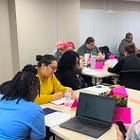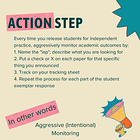Walk into any classroom, and you’ll see it—the I’m finished mindset in action. The work is turned in, pencils are down, and minds are off. Maybe students are chatting. Maybe they’re on their phones or computer games. Maybe they’re waiting for the next task.
The instinctive reaction? Shut down the cellphones. Enforce compliance. Make students work.
But that’s the wrong solution because it doesn’t address the real problem. The problem isn’t distractions. The problem is the mindset.
The Problem: The I’m Finished Mindset
The I’m finished mindset is deeply ingrained in many schools. It’s the idea that completing the task—turning something in—is the goal. Students learn to play the game of school: do the work, check the box, move on. It’s not about quality. It’s not about growth. It’s about being done.
It’s not just students. Many teachers unknowingly reinforce this mindset. They assign work, collect it, and grade it—without always ensuring that students understand what success looks like. When students turn in something (or nothing at all), they move on to the next task. There’s little time for revision, feedback, or pushing toward excellence.
The Solution: The Exemplar Mindset
Instead of asking, Is it done?, we should be asking, Is it excellent?
The exemplar mindset shifts the focus from completion to mastery. It’s built on a simple but powerful truth: You can’t reach the bar if you don’t know what the bar looks like.
This means students need to see high-quality examples of work before they begin. They need models of excellence—exemplars—to guide them. Teachers need to move beyond grading to coaching, using strategies like aggressive monitoring to help students close the gap between their work and the exemplar.
A Shift in Practice: Coaching Students to the Bar
This shift starts with teachers. Instead of assigning work and hoping for the best, we need to coach students toward excellence. That means:
Coaching, then grading: As students try to finish work, teachers can prompt students to think about their work:
How does this work compare to our exemplar? What specific changes would make it even stronger?"
What feedback would you give yourself on this work? What’s one revision you can make to push it further?
If you had to explain why this is high-quality work to someone else, what would you say?
What’s one part of your work that you’re proud of, and what’s one part you could refine?
If you had 10 more minutes to improve this, what would you do?
Using Exemplars: Before students begin, show them what high-quality work looks like. Break it down. What makes it strong? How does it meet expectations?
Setting Clear Success Criteria: Students should know exactly what they’re aiming for. The goal isn’t just “write an essay” or “solve these problems”—it’s write an essay with strong evidence and analysis or solve these problems while explaining your reasoning.
Implementing Aggressive Monitoring: Teachers must circulate, check for understanding, and provide immediate feedback. It’s not just about catching mistakes—it’s about coaching students to improve in real time.
Normalizing Revisions: If work isn’t meeting the bar, students should revise. Excellence isn’t a one-and-done process. It takes feedback, reflection, and another attempt.
When students understand the bar and receive coaching to reach it, they stop asking, “Am I done?” and start asking, “How can I make this better?”
Coaching Teachers into the Exemplar Mindset
If we want students to unlearn the I’m finished mindset, teachers must first make the shift themselves. Coaching teachers into the exemplar mindset requires helping them see that their role is not just to assign and assess but to guide students toward excellence actively.
Coaching Questions to Shift Mindset
Reframing the Goal
How do you know if a student has truly mastered this skill or concept?
If a student turned in a perfect version of this assignment, what would it look like?
What is the difference between “done” and “done well” in your classroom?
Using Exemplars
Have students seen an example of high-quality work before starting?
How did you break down the elements of an exemplar so students could replicate it?
What misconceptions might students have about what ‘good’ work looks like?
Monitoring for Understanding
As you circulate, what are you looking for in student work?
What is your plan when a student is off track—do they get a grade or guidance?
How do you ensure that students are improving their work before they submit it?
Encouraging Revisions and Growth
How often do students get opportunities to revise their work?
What language do you use to encourage revision without making it feel like failure?
How can you normalize revision as part of the learning process rather than a punishment for ‘not getting it right’ the first time?
Coaching Methods to Shift Practice
1. Model the Exemplar Mindset in PLCs
Use teacher work (lesson plans, assessments) to show the difference between finished and excellent.
Have teachers analyze student work against an exemplar and determine next steps for improvement.
2. Conduct Learning Walks Focused on Monitoring
Observe whether teachers are checking for understanding or just collecting work.
Provide real-time coaching: “What feedback will this student get before they turn this in?”
3. Implement a “Know the Bar, Coach to the Bar” Strategy
In PD sessions, have teachers practice coaching students toward an exemplar rather than just marking what’s wrong.
Use role-play scenarios where teachers must provide live feedback to ‘students’ (played by colleagues).
4. Use a Reflection Protocol for Assignments
Before planning a lesson, have teachers ask:
✅ What does success look like?
✅ How will students know if they’re meeting the standard?
✅ What feedback will I give before they turn it in?
5. Make Revision a Norm in Classrooms
Encourage teachers to allow resubmissions with structured feedback.
Shift grading policies to emphasize growth over completion.
Bottom Line
Coaching teachers into the exemplar mindset means helping them move from assigning work to coaching excellence. When teachers shift their practice, students follow—because they can’t reach the bar if they’ve never seen it.
Unlearning the I’m finished mindset requires more than new rules. It requires a cultural shift—one that redefines success in our classrooms. If we want students to care about learning, we must show them what excellence looks like, expect them to reach it, and support them.
Because the goal isn’t just to finish, the goal is to get it right.








